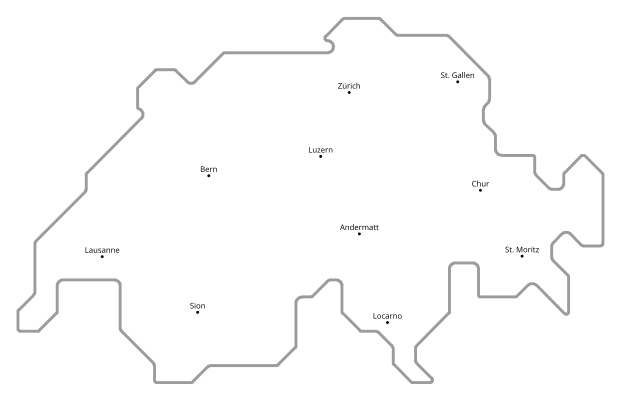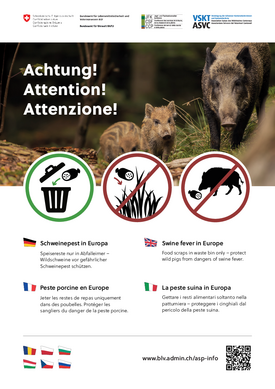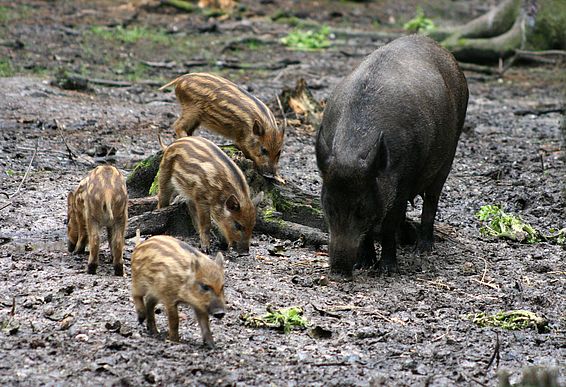14.09.2022 | Santina Russo | News WSL
African swine fever is now dangerously close to Switzerland. To protect wild and domestic pigs from the deadly animal disease, we humans must be careful when handling food waste. A new research study by the Swiss Federal Institute for Forest, Snow and Landscape Research WSL shows where this is particularly necessary.
"Attention! Swine fever in Europe. Food leftovers only in waste bins - protect wild pigs from dangerous swine fever." Such warning posters can be found at several Swiss motorway rest areas and fireplaces. With good reason: If we humans do not carefully dispose food waste, we become the most dangerous factor in the transmission of African swine fever.
This viral disease affects wild and domestic pigs and is fatal: Infected animals get high fever and die within 7 to 10 days. So far, there is neither a cure nor a vaccination. The pathogen cannot harm humans, but it would be devastating for domestic pig farms. "That is why we need to learn as much as possible about how the virus spreads and the routes it could take to reach Switzerland," says Rolf Grütter, researcher at WSL. Together with his team, he has now identified the most likely introduction sites for the virus and the regions in which pig farms should particularly protect themselves.
Virus in a sandwich
The animal disease has almost encircled Switzerland: Infected wild pigs were found in Italy, Belgium on the border with France and Germany. And last spring there was an outbreak in a domestic pig farm in Baden-Württemberg - close to the Swiss border.
It is true that the disease spreads steadily among wild pigs in Europe even without human influence. However, the virus travels faster with humans. It is extremely resistant and remains virulent for months even in pork products such as raw ham or salami. "This means that the virus can travel long distances in people's food within a short time," says Grütter. If half-eaten sandwiches end up on the ground or in open rubbish bins at rest stops, the local wild pigs are happy to feed on the easily accessible food. They then can pass the pathogen on to domestic pigs when they approach enclosures to snatch food or to mate.
Where motorways and wild boars meet
In order to identify the places with the greatest risk of introduction, Rolf Grütter and doctoral student Maria Elena Vargas Amado from his team first modelled the potential distribution of wild pigs in Switzerland. They then used this distribution together with the cantonal hunting statistics of the last seven years and with other data to model the actual distribution and relative abundance of wild pigs in Switzerland. In the next step, they identified the most frequently used car routes and rest areas and compared their locations with the modelled distribution of wild pigs. The result: Particularly rest areas on the north of the much-used A1 from Geneva to St. Margrethen border on dense populations of wild boar and are likely introduction sites. Also, several rest areas on the A2 in Ticino are located in wild pig areas. "In concrete terms, we identified 57 resting places where there is a high risk of introduction," says Vargas Amado. In 14 cantons, there are one or more high-risk service areas.
Finally, the researchers also took into account the location of pig farms and how they are kept. "Pigs kept in free-range husbandry come into contact with wild pigs more easily than those that are partly kept in outdoor enclosures or even only indoors," says Vargas Amado. The combination of all these factors - wild boar distribution, rest areas and pig farms - finally resulted in the most likely transmission sites for the virus to domestic pigs. Risk maps for the whole of Switzerland show where pig farms should particularly protect their animals from contact with wild pigs, for example by installing better fences. This includes areas in the cantons of Bern, Solothurn, Basel-Landschaft, Aargau, and Zürich north of the A1 as well as regions in the canton of Schaffhausen on both sides of the A4 and in the canton of Ticino on both sides of the A2.
“With our results, authorities and farms now have a detailed basis to protect domestic pigs even better in the future," says Rolf Grütter.
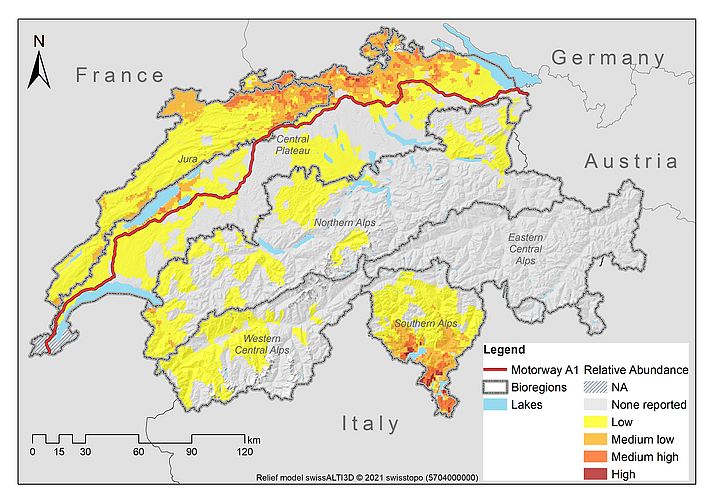
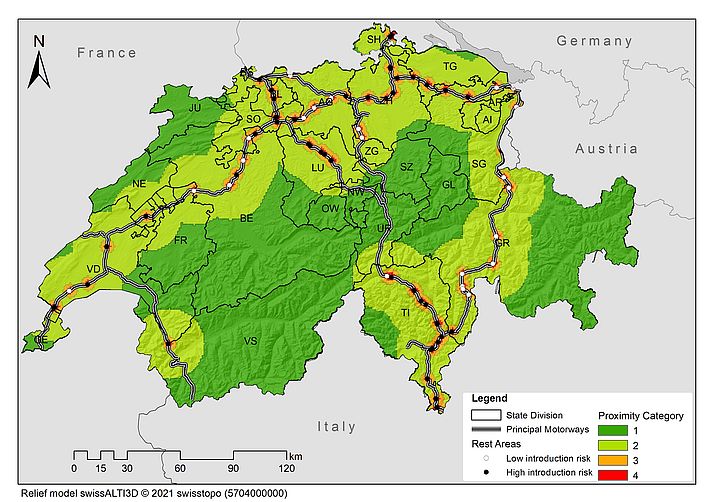
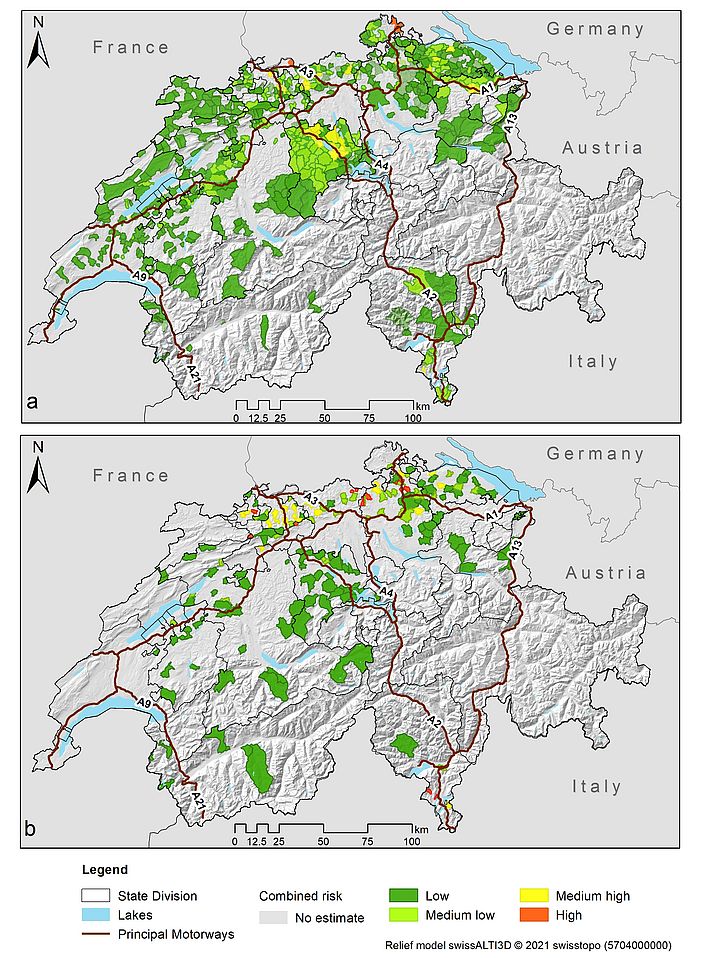
Contact
Publications
Projects Datensätze
Copyright
WSL and SLF provide the artwork for imaging of press articles relating to this media release for free. Transferring and saving the images in image databases and saving of images by third parties is not allowed.
